Economics Assignment 12: Analysis of Monopoly Market Dynamics
VerifiedAdded on 2020/02/24
|12
|2762
|48
Essay
AI Summary
This economics assignment delves into the characteristics of a monopoly market, exploring its structure, price-setting mechanisms, and the rationale behind government intervention. The essay begins by defining the concept of a monopoly and then investigates why governments regulate the price-setting policies of natural monopolies, analyzing how these businesses affect consumers in a free market. It examines the characteristics of a monopoly market, including the absence of competition, high barriers to entry, and price-making power, and discusses the role of government in preventing overpricing, maintaining service quality, and promoting competition. The assignment also provides a case study of EnergyAustralia to illustrate the impact of deregulation on consumers and market dynamics. The essay concludes by highlighting the importance of government regulation in ensuring fair pricing, preventing market failures, and fostering economic growth.
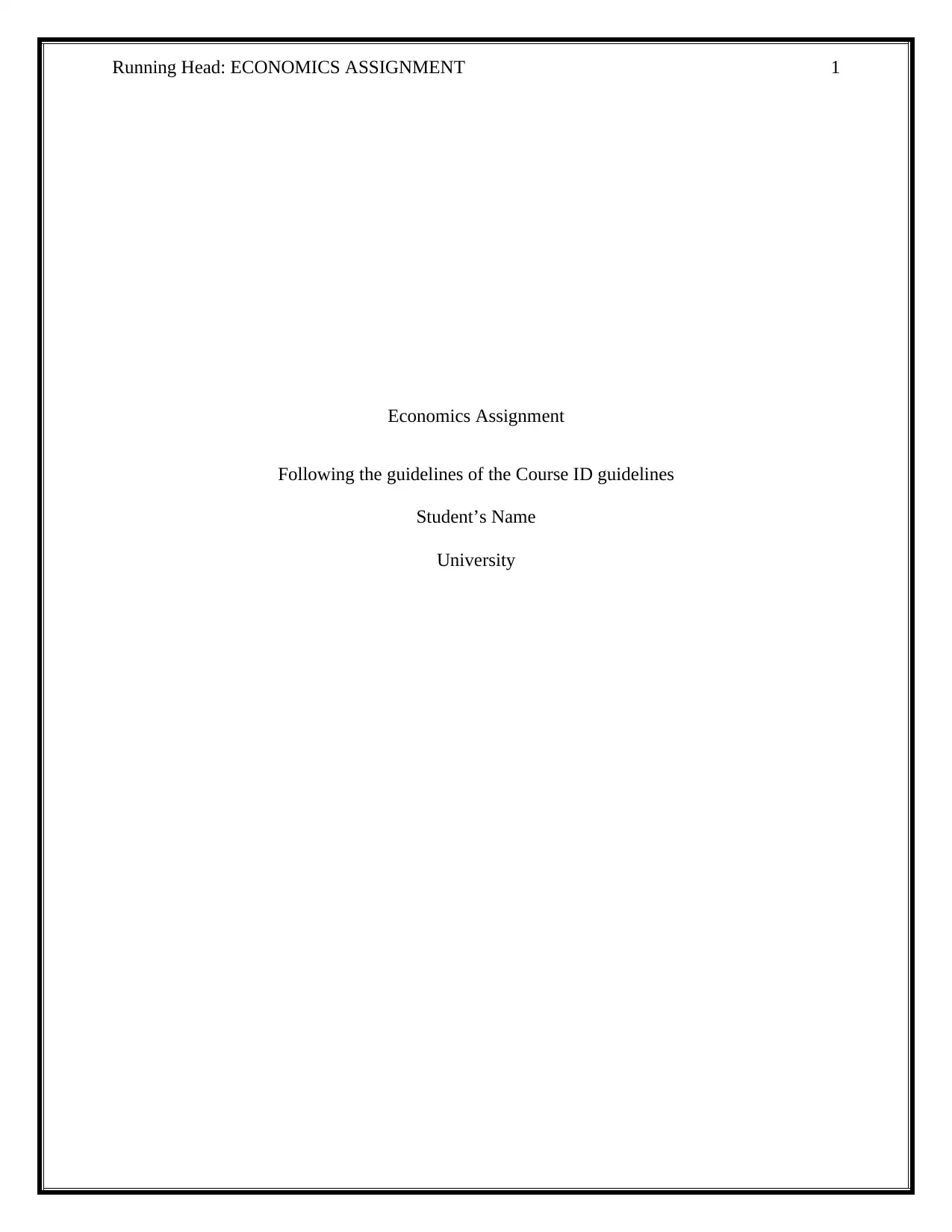
Running Head: ECONOMICS ASSIGNMENT 1
Economics Assignment
Following the guidelines of the Course ID guidelines
Student’s Name
University
Economics Assignment
Following the guidelines of the Course ID guidelines
Student’s Name
University
Paraphrase This Document
Need a fresh take? Get an instant paraphrase of this document with our AI Paraphraser
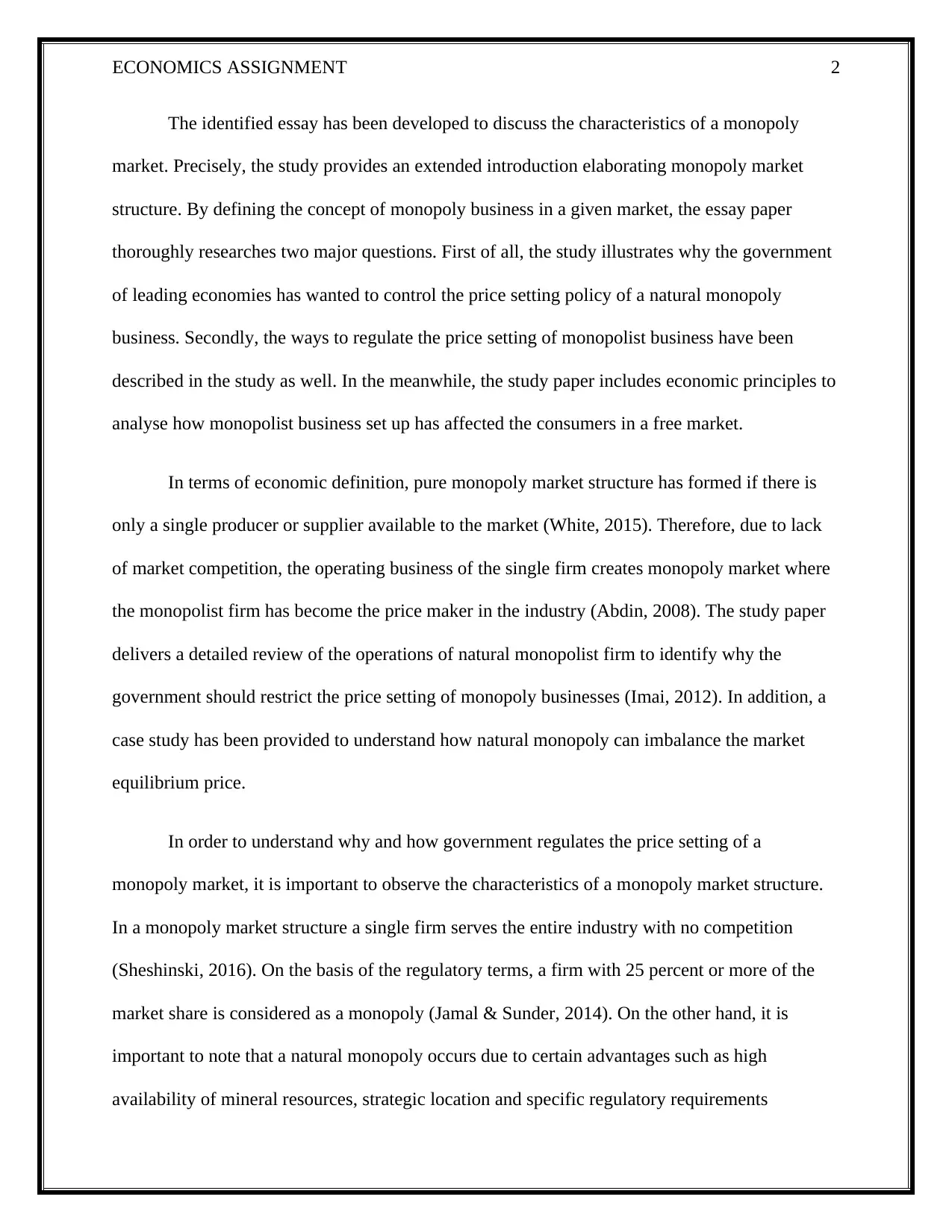
ECONOMICS ASSIGNMENT 2
The identified essay has been developed to discuss the characteristics of a monopoly
market. Precisely, the study provides an extended introduction elaborating monopoly market
structure. By defining the concept of monopoly business in a given market, the essay paper
thoroughly researches two major questions. First of all, the study illustrates why the government
of leading economies has wanted to control the price setting policy of a natural monopoly
business. Secondly, the ways to regulate the price setting of monopolist business have been
described in the study as well. In the meanwhile, the study paper includes economic principles to
analyse how monopolist business set up has affected the consumers in a free market.
In terms of economic definition, pure monopoly market structure has formed if there is
only a single producer or supplier available to the market (White, 2015). Therefore, due to lack
of market competition, the operating business of the single firm creates monopoly market where
the monopolist firm has become the price maker in the industry (Abdin, 2008). The study paper
delivers a detailed review of the operations of natural monopolist firm to identify why the
government should restrict the price setting of monopoly businesses (Imai, 2012). In addition, a
case study has been provided to understand how natural monopoly can imbalance the market
equilibrium price.
In order to understand why and how government regulates the price setting of a
monopoly market, it is important to observe the characteristics of a monopoly market structure.
In a monopoly market structure a single firm serves the entire industry with no competition
(Sheshinski, 2016). On the basis of the regulatory terms, a firm with 25 percent or more of the
market share is considered as a monopoly (Jamal & Sunder, 2014). On the other hand, it is
important to note that a natural monopoly occurs due to certain advantages such as high
availability of mineral resources, strategic location and specific regulatory requirements
The identified essay has been developed to discuss the characteristics of a monopoly
market. Precisely, the study provides an extended introduction elaborating monopoly market
structure. By defining the concept of monopoly business in a given market, the essay paper
thoroughly researches two major questions. First of all, the study illustrates why the government
of leading economies has wanted to control the price setting policy of a natural monopoly
business. Secondly, the ways to regulate the price setting of monopolist business have been
described in the study as well. In the meanwhile, the study paper includes economic principles to
analyse how monopolist business set up has affected the consumers in a free market.
In terms of economic definition, pure monopoly market structure has formed if there is
only a single producer or supplier available to the market (White, 2015). Therefore, due to lack
of market competition, the operating business of the single firm creates monopoly market where
the monopolist firm has become the price maker in the industry (Abdin, 2008). The study paper
delivers a detailed review of the operations of natural monopolist firm to identify why the
government should restrict the price setting of monopoly businesses (Imai, 2012). In addition, a
case study has been provided to understand how natural monopoly can imbalance the market
equilibrium price.
In order to understand why and how government regulates the price setting of a
monopoly market, it is important to observe the characteristics of a monopoly market structure.
In a monopoly market structure a single firm serves the entire industry with no competition
(Sheshinski, 2016). On the basis of the regulatory terms, a firm with 25 percent or more of the
market share is considered as a monopoly (Jamal & Sunder, 2014). On the other hand, it is
important to note that a natural monopoly occurs due to certain advantages such as high
availability of mineral resources, strategic location and specific regulatory requirements
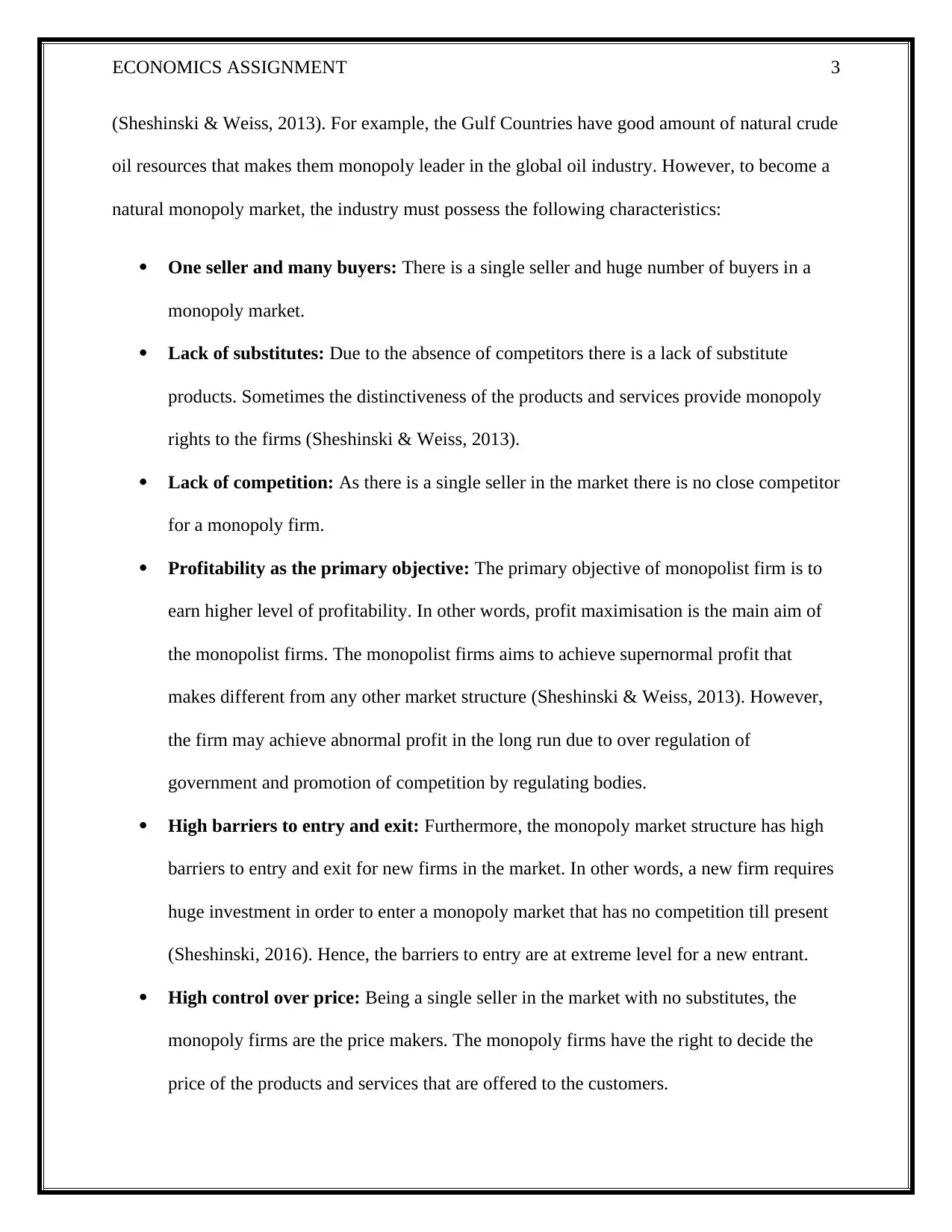
ECONOMICS ASSIGNMENT 3
(Sheshinski & Weiss, 2013). For example, the Gulf Countries have good amount of natural crude
oil resources that makes them monopoly leader in the global oil industry. However, to become a
natural monopoly market, the industry must possess the following characteristics:
One seller and many buyers: There is a single seller and huge number of buyers in a
monopoly market.
Lack of substitutes: Due to the absence of competitors there is a lack of substitute
products. Sometimes the distinctiveness of the products and services provide monopoly
rights to the firms (Sheshinski & Weiss, 2013).
Lack of competition: As there is a single seller in the market there is no close competitor
for a monopoly firm.
Profitability as the primary objective: The primary objective of monopolist firm is to
earn higher level of profitability. In other words, profit maximisation is the main aim of
the monopolist firms. The monopolist firms aims to achieve supernormal profit that
makes different from any other market structure (Sheshinski & Weiss, 2013). However,
the firm may achieve abnormal profit in the long run due to over regulation of
government and promotion of competition by regulating bodies.
High barriers to entry and exit: Furthermore, the monopoly market structure has high
barriers to entry and exit for new firms in the market. In other words, a new firm requires
huge investment in order to enter a monopoly market that has no competition till present
(Sheshinski, 2016). Hence, the barriers to entry are at extreme level for a new entrant.
High control over price: Being a single seller in the market with no substitutes, the
monopoly firms are the price makers. The monopoly firms have the right to decide the
price of the products and services that are offered to the customers.
(Sheshinski & Weiss, 2013). For example, the Gulf Countries have good amount of natural crude
oil resources that makes them monopoly leader in the global oil industry. However, to become a
natural monopoly market, the industry must possess the following characteristics:
One seller and many buyers: There is a single seller and huge number of buyers in a
monopoly market.
Lack of substitutes: Due to the absence of competitors there is a lack of substitute
products. Sometimes the distinctiveness of the products and services provide monopoly
rights to the firms (Sheshinski & Weiss, 2013).
Lack of competition: As there is a single seller in the market there is no close competitor
for a monopoly firm.
Profitability as the primary objective: The primary objective of monopolist firm is to
earn higher level of profitability. In other words, profit maximisation is the main aim of
the monopolist firms. The monopolist firms aims to achieve supernormal profit that
makes different from any other market structure (Sheshinski & Weiss, 2013). However,
the firm may achieve abnormal profit in the long run due to over regulation of
government and promotion of competition by regulating bodies.
High barriers to entry and exit: Furthermore, the monopoly market structure has high
barriers to entry and exit for new firms in the market. In other words, a new firm requires
huge investment in order to enter a monopoly market that has no competition till present
(Sheshinski, 2016). Hence, the barriers to entry are at extreme level for a new entrant.
High control over price: Being a single seller in the market with no substitutes, the
monopoly firms are the price makers. The monopoly firms have the right to decide the
price of the products and services that are offered to the customers.
⊘ This is a preview!⊘
Do you want full access?
Subscribe today to unlock all pages.

Trusted by 1+ million students worldwide
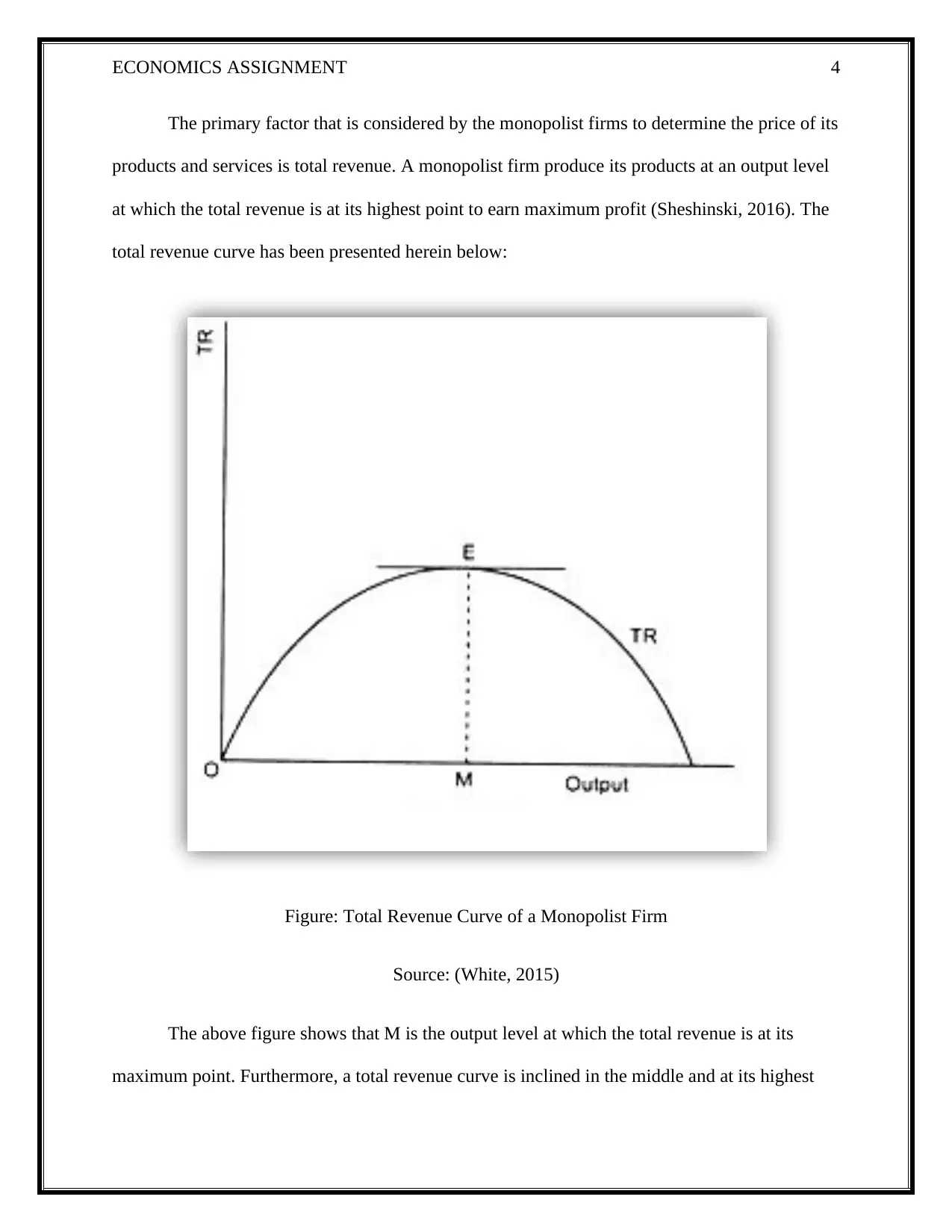
ECONOMICS ASSIGNMENT 4
The primary factor that is considered by the monopolist firms to determine the price of its
products and services is total revenue. A monopolist firm produce its products at an output level
at which the total revenue is at its highest point to earn maximum profit (Sheshinski, 2016). The
total revenue curve has been presented herein below:
Figure: Total Revenue Curve of a Monopolist Firm
Source: (White, 2015)
The above figure shows that M is the output level at which the total revenue is at its
maximum point. Furthermore, a total revenue curve is inclined in the middle and at its highest
The primary factor that is considered by the monopolist firms to determine the price of its
products and services is total revenue. A monopolist firm produce its products at an output level
at which the total revenue is at its highest point to earn maximum profit (Sheshinski, 2016). The
total revenue curve has been presented herein below:
Figure: Total Revenue Curve of a Monopolist Firm
Source: (White, 2015)
The above figure shows that M is the output level at which the total revenue is at its
maximum point. Furthermore, a total revenue curve is inclined in the middle and at its highest
Paraphrase This Document
Need a fresh take? Get an instant paraphrase of this document with our AI Paraphraser
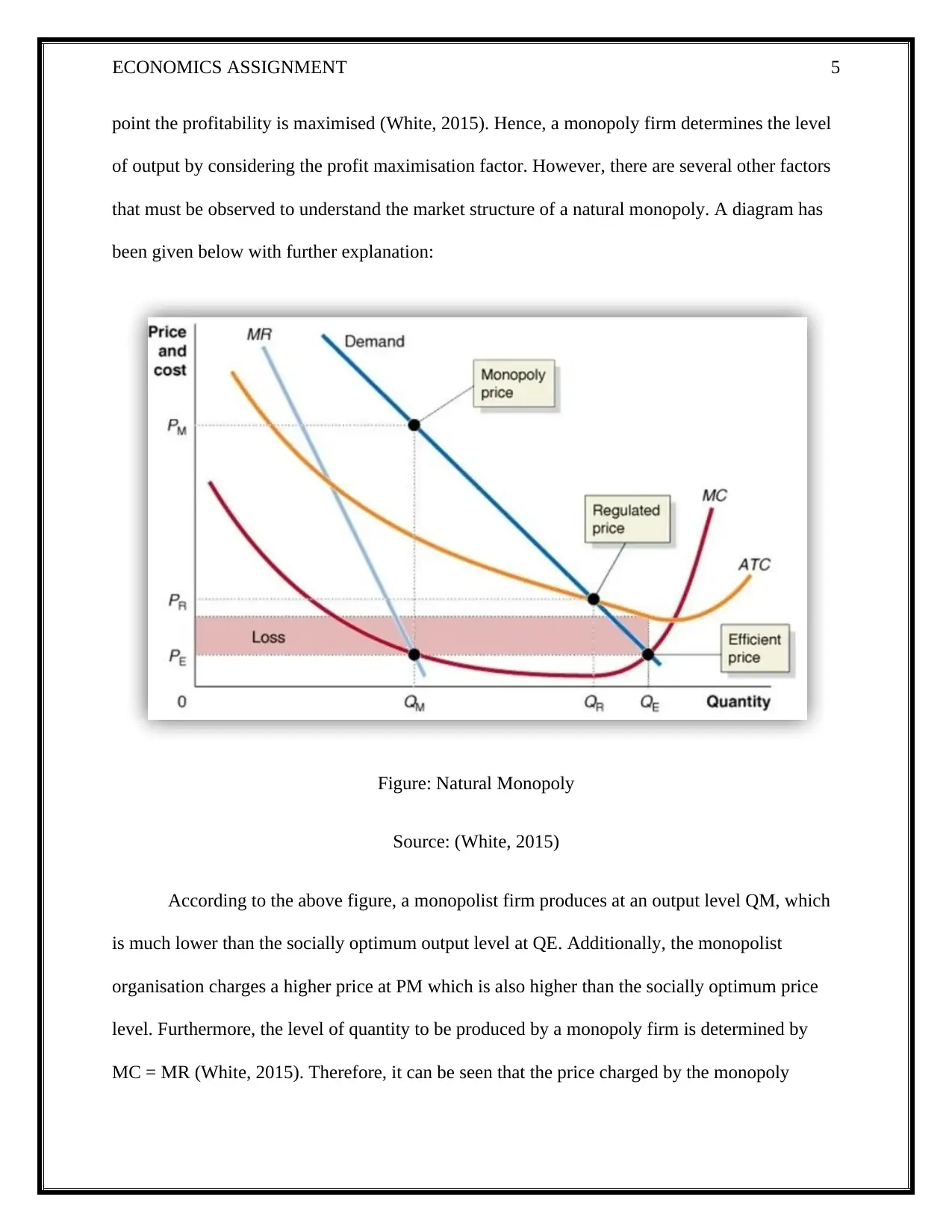
ECONOMICS ASSIGNMENT 5
point the profitability is maximised (White, 2015). Hence, a monopoly firm determines the level
of output by considering the profit maximisation factor. However, there are several other factors
that must be observed to understand the market structure of a natural monopoly. A diagram has
been given below with further explanation:
Figure: Natural Monopoly
Source: (White, 2015)
According to the above figure, a monopolist firm produces at an output level QM, which
is much lower than the socially optimum output level at QE. Additionally, the monopolist
organisation charges a higher price at PM which is also higher than the socially optimum price
level. Furthermore, the level of quantity to be produced by a monopoly firm is determined by
MC = MR (White, 2015). Therefore, it can be seen that the price charged by the monopoly
point the profitability is maximised (White, 2015). Hence, a monopoly firm determines the level
of output by considering the profit maximisation factor. However, there are several other factors
that must be observed to understand the market structure of a natural monopoly. A diagram has
been given below with further explanation:
Figure: Natural Monopoly
Source: (White, 2015)
According to the above figure, a monopolist firm produces at an output level QM, which
is much lower than the socially optimum output level at QE. Additionally, the monopolist
organisation charges a higher price at PM which is also higher than the socially optimum price
level. Furthermore, the level of quantity to be produced by a monopoly firm is determined by
MC = MR (White, 2015). Therefore, it can be seen that the price charged by the monopoly
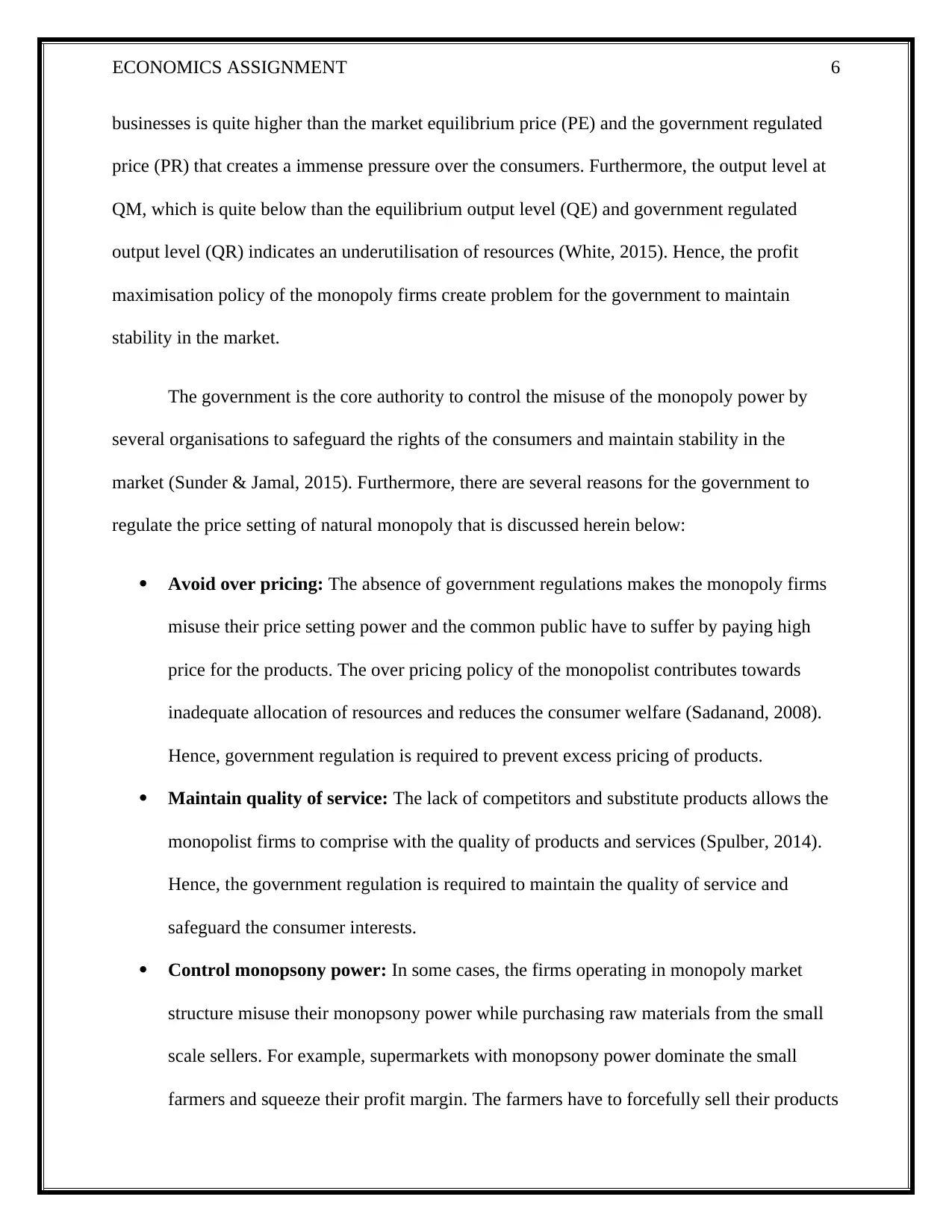
ECONOMICS ASSIGNMENT 6
businesses is quite higher than the market equilibrium price (PE) and the government regulated
price (PR) that creates a immense pressure over the consumers. Furthermore, the output level at
QM, which is quite below than the equilibrium output level (QE) and government regulated
output level (QR) indicates an underutilisation of resources (White, 2015). Hence, the profit
maximisation policy of the monopoly firms create problem for the government to maintain
stability in the market.
The government is the core authority to control the misuse of the monopoly power by
several organisations to safeguard the rights of the consumers and maintain stability in the
market (Sunder & Jamal, 2015). Furthermore, there are several reasons for the government to
regulate the price setting of natural monopoly that is discussed herein below:
Avoid over pricing: The absence of government regulations makes the monopoly firms
misuse their price setting power and the common public have to suffer by paying high
price for the products. The over pricing policy of the monopolist contributes towards
inadequate allocation of resources and reduces the consumer welfare (Sadanand, 2008).
Hence, government regulation is required to prevent excess pricing of products.
Maintain quality of service: The lack of competitors and substitute products allows the
monopolist firms to comprise with the quality of products and services (Spulber, 2014).
Hence, the government regulation is required to maintain the quality of service and
safeguard the consumer interests.
Control monopsony power: In some cases, the firms operating in monopoly market
structure misuse their monopsony power while purchasing raw materials from the small
scale sellers. For example, supermarkets with monopsony power dominate the small
farmers and squeeze their profit margin. The farmers have to forcefully sell their products
businesses is quite higher than the market equilibrium price (PE) and the government regulated
price (PR) that creates a immense pressure over the consumers. Furthermore, the output level at
QM, which is quite below than the equilibrium output level (QE) and government regulated
output level (QR) indicates an underutilisation of resources (White, 2015). Hence, the profit
maximisation policy of the monopoly firms create problem for the government to maintain
stability in the market.
The government is the core authority to control the misuse of the monopoly power by
several organisations to safeguard the rights of the consumers and maintain stability in the
market (Sunder & Jamal, 2015). Furthermore, there are several reasons for the government to
regulate the price setting of natural monopoly that is discussed herein below:
Avoid over pricing: The absence of government regulations makes the monopoly firms
misuse their price setting power and the common public have to suffer by paying high
price for the products. The over pricing policy of the monopolist contributes towards
inadequate allocation of resources and reduces the consumer welfare (Sadanand, 2008).
Hence, government regulation is required to prevent excess pricing of products.
Maintain quality of service: The lack of competitors and substitute products allows the
monopolist firms to comprise with the quality of products and services (Spulber, 2014).
Hence, the government regulation is required to maintain the quality of service and
safeguard the consumer interests.
Control monopsony power: In some cases, the firms operating in monopoly market
structure misuse their monopsony power while purchasing raw materials from the small
scale sellers. For example, supermarkets with monopsony power dominate the small
farmers and squeeze their profit margin. The farmers have to forcefully sell their products
⊘ This is a preview!⊘
Do you want full access?
Subscribe today to unlock all pages.

Trusted by 1+ million students worldwide
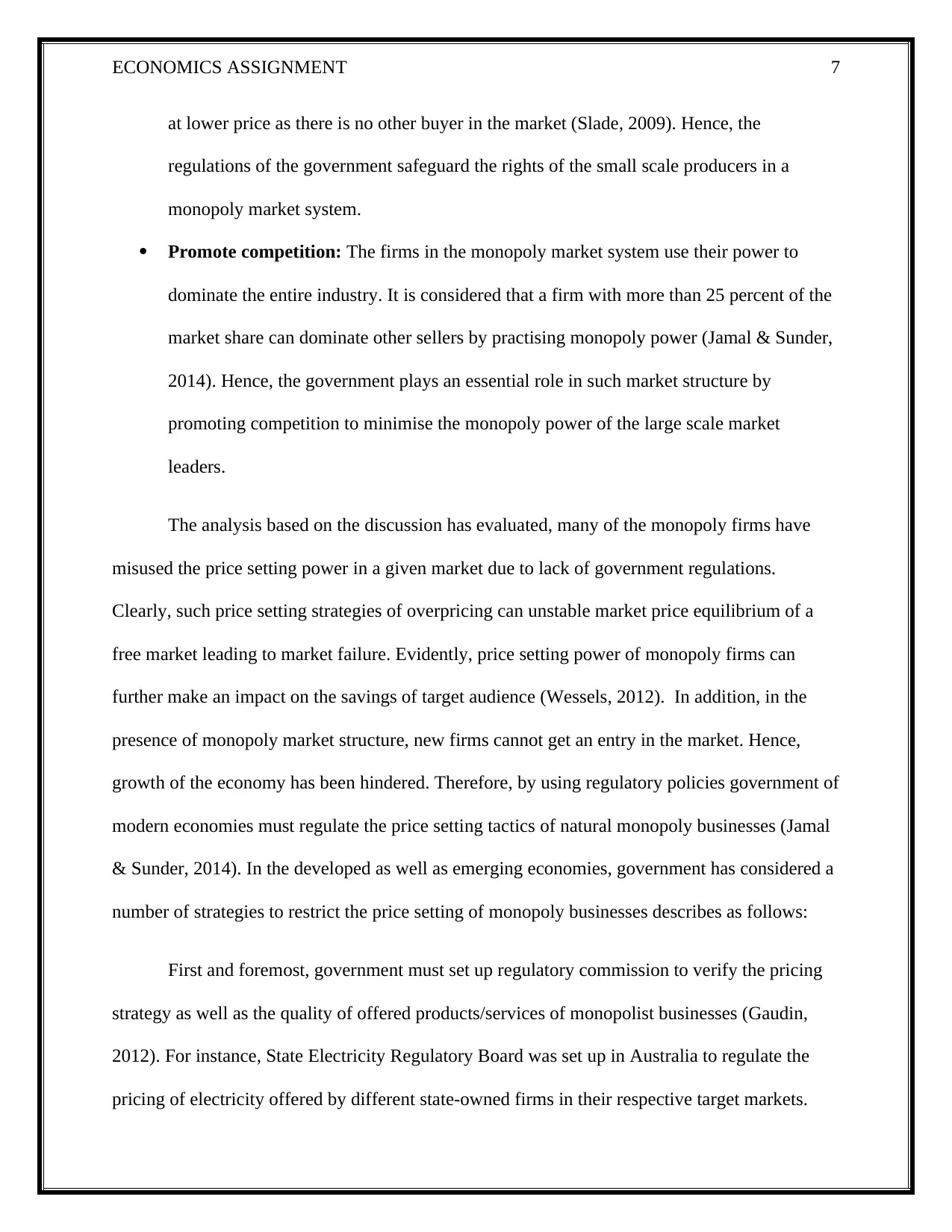
ECONOMICS ASSIGNMENT 7
at lower price as there is no other buyer in the market (Slade, 2009). Hence, the
regulations of the government safeguard the rights of the small scale producers in a
monopoly market system.
Promote competition: The firms in the monopoly market system use their power to
dominate the entire industry. It is considered that a firm with more than 25 percent of the
market share can dominate other sellers by practising monopoly power (Jamal & Sunder,
2014). Hence, the government plays an essential role in such market structure by
promoting competition to minimise the monopoly power of the large scale market
leaders.
The analysis based on the discussion has evaluated, many of the monopoly firms have
misused the price setting power in a given market due to lack of government regulations.
Clearly, such price setting strategies of overpricing can unstable market price equilibrium of a
free market leading to market failure. Evidently, price setting power of monopoly firms can
further make an impact on the savings of target audience (Wessels, 2012). In addition, in the
presence of monopoly market structure, new firms cannot get an entry in the market. Hence,
growth of the economy has been hindered. Therefore, by using regulatory policies government of
modern economies must regulate the price setting tactics of natural monopoly businesses (Jamal
& Sunder, 2014). In the developed as well as emerging economies, government has considered a
number of strategies to restrict the price setting of monopoly businesses describes as follows:
First and foremost, government must set up regulatory commission to verify the pricing
strategy as well as the quality of offered products/services of monopolist businesses (Gaudin,
2012). For instance, State Electricity Regulatory Board was set up in Australia to regulate the
pricing of electricity offered by different state-owned firms in their respective target markets.
at lower price as there is no other buyer in the market (Slade, 2009). Hence, the
regulations of the government safeguard the rights of the small scale producers in a
monopoly market system.
Promote competition: The firms in the monopoly market system use their power to
dominate the entire industry. It is considered that a firm with more than 25 percent of the
market share can dominate other sellers by practising monopoly power (Jamal & Sunder,
2014). Hence, the government plays an essential role in such market structure by
promoting competition to minimise the monopoly power of the large scale market
leaders.
The analysis based on the discussion has evaluated, many of the monopoly firms have
misused the price setting power in a given market due to lack of government regulations.
Clearly, such price setting strategies of overpricing can unstable market price equilibrium of a
free market leading to market failure. Evidently, price setting power of monopoly firms can
further make an impact on the savings of target audience (Wessels, 2012). In addition, in the
presence of monopoly market structure, new firms cannot get an entry in the market. Hence,
growth of the economy has been hindered. Therefore, by using regulatory policies government of
modern economies must regulate the price setting tactics of natural monopoly businesses (Jamal
& Sunder, 2014). In the developed as well as emerging economies, government has considered a
number of strategies to restrict the price setting of monopoly businesses describes as follows:
First and foremost, government must set up regulatory commission to verify the pricing
strategy as well as the quality of offered products/services of monopolist businesses (Gaudin,
2012). For instance, State Electricity Regulatory Board was set up in Australia to regulate the
pricing of electricity offered by different state-owned firms in their respective target markets.
Paraphrase This Document
Need a fresh take? Get an instant paraphrase of this document with our AI Paraphraser
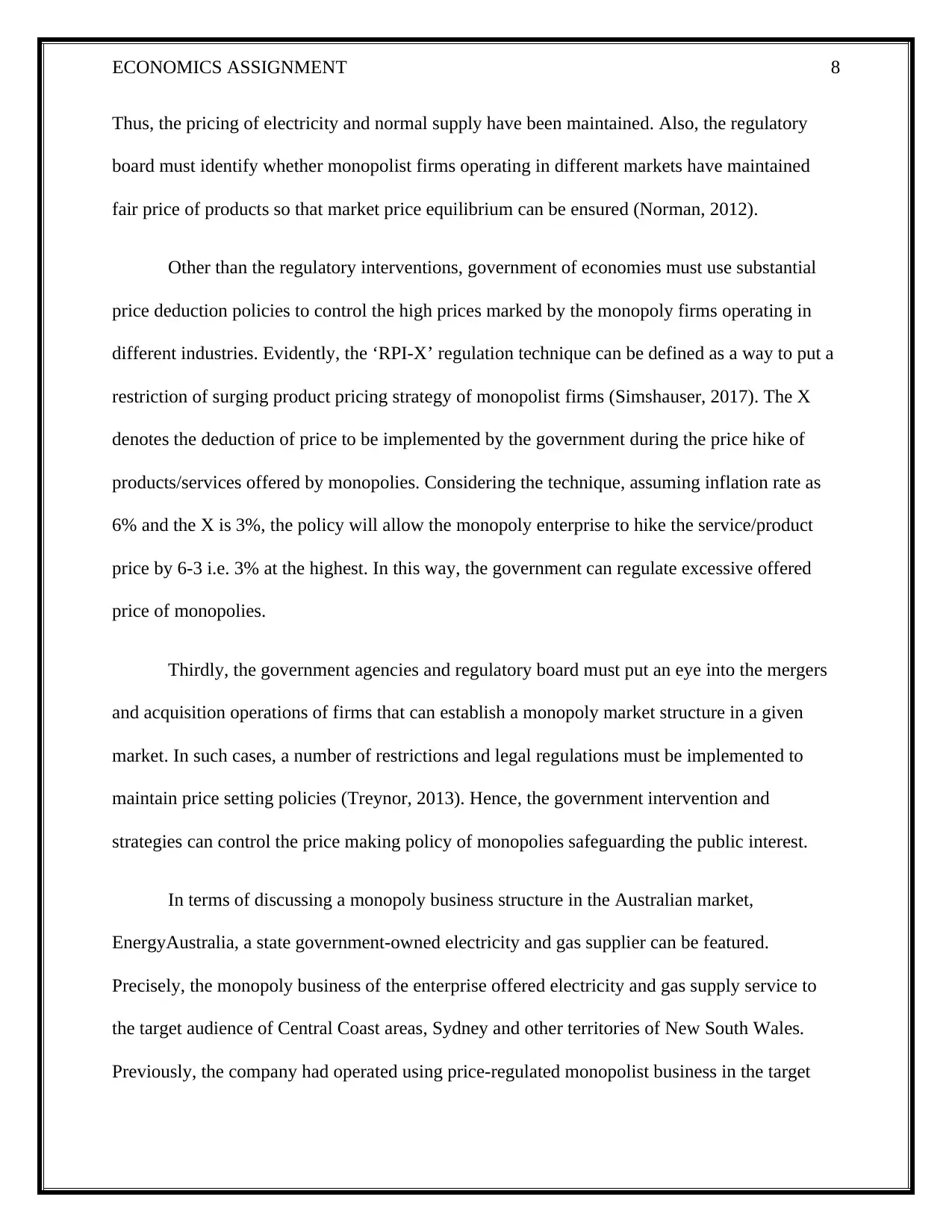
ECONOMICS ASSIGNMENT 8
Thus, the pricing of electricity and normal supply have been maintained. Also, the regulatory
board must identify whether monopolist firms operating in different markets have maintained
fair price of products so that market price equilibrium can be ensured (Norman, 2012).
Other than the regulatory interventions, government of economies must use substantial
price deduction policies to control the high prices marked by the monopoly firms operating in
different industries. Evidently, the ‘RPI-X’ regulation technique can be defined as a way to put a
restriction of surging product pricing strategy of monopolist firms (Simshauser, 2017). The X
denotes the deduction of price to be implemented by the government during the price hike of
products/services offered by monopolies. Considering the technique, assuming inflation rate as
6% and the X is 3%, the policy will allow the monopoly enterprise to hike the service/product
price by 6-3 i.e. 3% at the highest. In this way, the government can regulate excessive offered
price of monopolies.
Thirdly, the government agencies and regulatory board must put an eye into the mergers
and acquisition operations of firms that can establish a monopoly market structure in a given
market. In such cases, a number of restrictions and legal regulations must be implemented to
maintain price setting policies (Treynor, 2013). Hence, the government intervention and
strategies can control the price making policy of monopolies safeguarding the public interest.
In terms of discussing a monopoly business structure in the Australian market,
EnergyAustralia, a state government-owned electricity and gas supplier can be featured.
Precisely, the monopoly business of the enterprise offered electricity and gas supply service to
the target audience of Central Coast areas, Sydney and other territories of New South Wales.
Previously, the company had operated using price-regulated monopolist business in the target
Thus, the pricing of electricity and normal supply have been maintained. Also, the regulatory
board must identify whether monopolist firms operating in different markets have maintained
fair price of products so that market price equilibrium can be ensured (Norman, 2012).
Other than the regulatory interventions, government of economies must use substantial
price deduction policies to control the high prices marked by the monopoly firms operating in
different industries. Evidently, the ‘RPI-X’ regulation technique can be defined as a way to put a
restriction of surging product pricing strategy of monopolist firms (Simshauser, 2017). The X
denotes the deduction of price to be implemented by the government during the price hike of
products/services offered by monopolies. Considering the technique, assuming inflation rate as
6% and the X is 3%, the policy will allow the monopoly enterprise to hike the service/product
price by 6-3 i.e. 3% at the highest. In this way, the government can regulate excessive offered
price of monopolies.
Thirdly, the government agencies and regulatory board must put an eye into the mergers
and acquisition operations of firms that can establish a monopoly market structure in a given
market. In such cases, a number of restrictions and legal regulations must be implemented to
maintain price setting policies (Treynor, 2013). Hence, the government intervention and
strategies can control the price making policy of monopolies safeguarding the public interest.
In terms of discussing a monopoly business structure in the Australian market,
EnergyAustralia, a state government-owned electricity and gas supplier can be featured.
Precisely, the monopoly business of the enterprise offered electricity and gas supply service to
the target audience of Central Coast areas, Sydney and other territories of New South Wales.
Previously, the company had operated using price-regulated monopolist business in the target
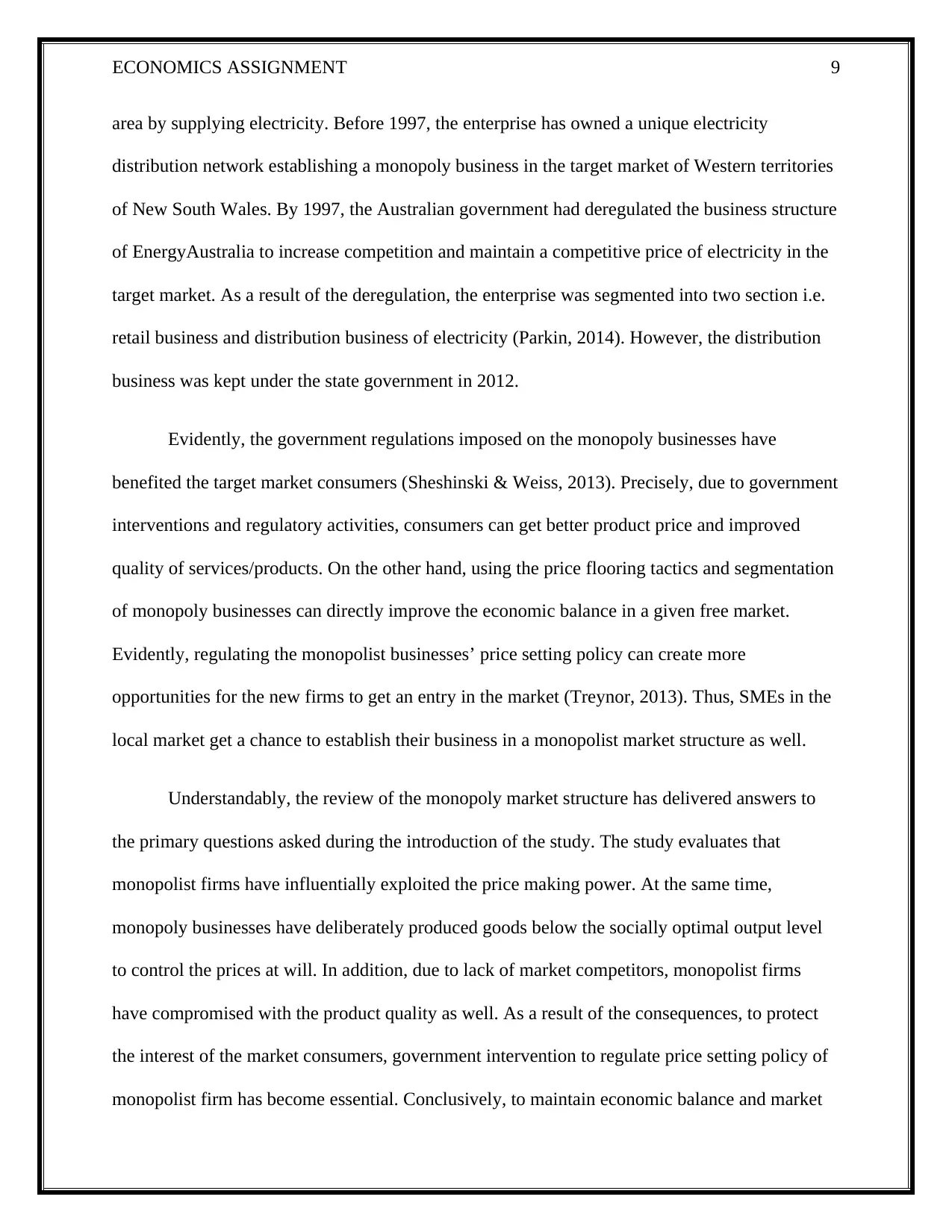
ECONOMICS ASSIGNMENT 9
area by supplying electricity. Before 1997, the enterprise has owned a unique electricity
distribution network establishing a monopoly business in the target market of Western territories
of New South Wales. By 1997, the Australian government had deregulated the business structure
of EnergyAustralia to increase competition and maintain a competitive price of electricity in the
target market. As a result of the deregulation, the enterprise was segmented into two section i.e.
retail business and distribution business of electricity (Parkin, 2014). However, the distribution
business was kept under the state government in 2012.
Evidently, the government regulations imposed on the monopoly businesses have
benefited the target market consumers (Sheshinski & Weiss, 2013). Precisely, due to government
interventions and regulatory activities, consumers can get better product price and improved
quality of services/products. On the other hand, using the price flooring tactics and segmentation
of monopoly businesses can directly improve the economic balance in a given free market.
Evidently, regulating the monopolist businesses’ price setting policy can create more
opportunities for the new firms to get an entry in the market (Treynor, 2013). Thus, SMEs in the
local market get a chance to establish their business in a monopolist market structure as well.
Understandably, the review of the monopoly market structure has delivered answers to
the primary questions asked during the introduction of the study. The study evaluates that
monopolist firms have influentially exploited the price making power. At the same time,
monopoly businesses have deliberately produced goods below the socially optimal output level
to control the prices at will. In addition, due to lack of market competitors, monopolist firms
have compromised with the product quality as well. As a result of the consequences, to protect
the interest of the market consumers, government intervention to regulate price setting policy of
monopolist firm has become essential. Conclusively, to maintain economic balance and market
area by supplying electricity. Before 1997, the enterprise has owned a unique electricity
distribution network establishing a monopoly business in the target market of Western territories
of New South Wales. By 1997, the Australian government had deregulated the business structure
of EnergyAustralia to increase competition and maintain a competitive price of electricity in the
target market. As a result of the deregulation, the enterprise was segmented into two section i.e.
retail business and distribution business of electricity (Parkin, 2014). However, the distribution
business was kept under the state government in 2012.
Evidently, the government regulations imposed on the monopoly businesses have
benefited the target market consumers (Sheshinski & Weiss, 2013). Precisely, due to government
interventions and regulatory activities, consumers can get better product price and improved
quality of services/products. On the other hand, using the price flooring tactics and segmentation
of monopoly businesses can directly improve the economic balance in a given free market.
Evidently, regulating the monopolist businesses’ price setting policy can create more
opportunities for the new firms to get an entry in the market (Treynor, 2013). Thus, SMEs in the
local market get a chance to establish their business in a monopolist market structure as well.
Understandably, the review of the monopoly market structure has delivered answers to
the primary questions asked during the introduction of the study. The study evaluates that
monopolist firms have influentially exploited the price making power. At the same time,
monopoly businesses have deliberately produced goods below the socially optimal output level
to control the prices at will. In addition, due to lack of market competitors, monopolist firms
have compromised with the product quality as well. As a result of the consequences, to protect
the interest of the market consumers, government intervention to regulate price setting policy of
monopolist firm has become essential. Conclusively, to maintain economic balance and market
⊘ This is a preview!⊘
Do you want full access?
Subscribe today to unlock all pages.

Trusted by 1+ million students worldwide
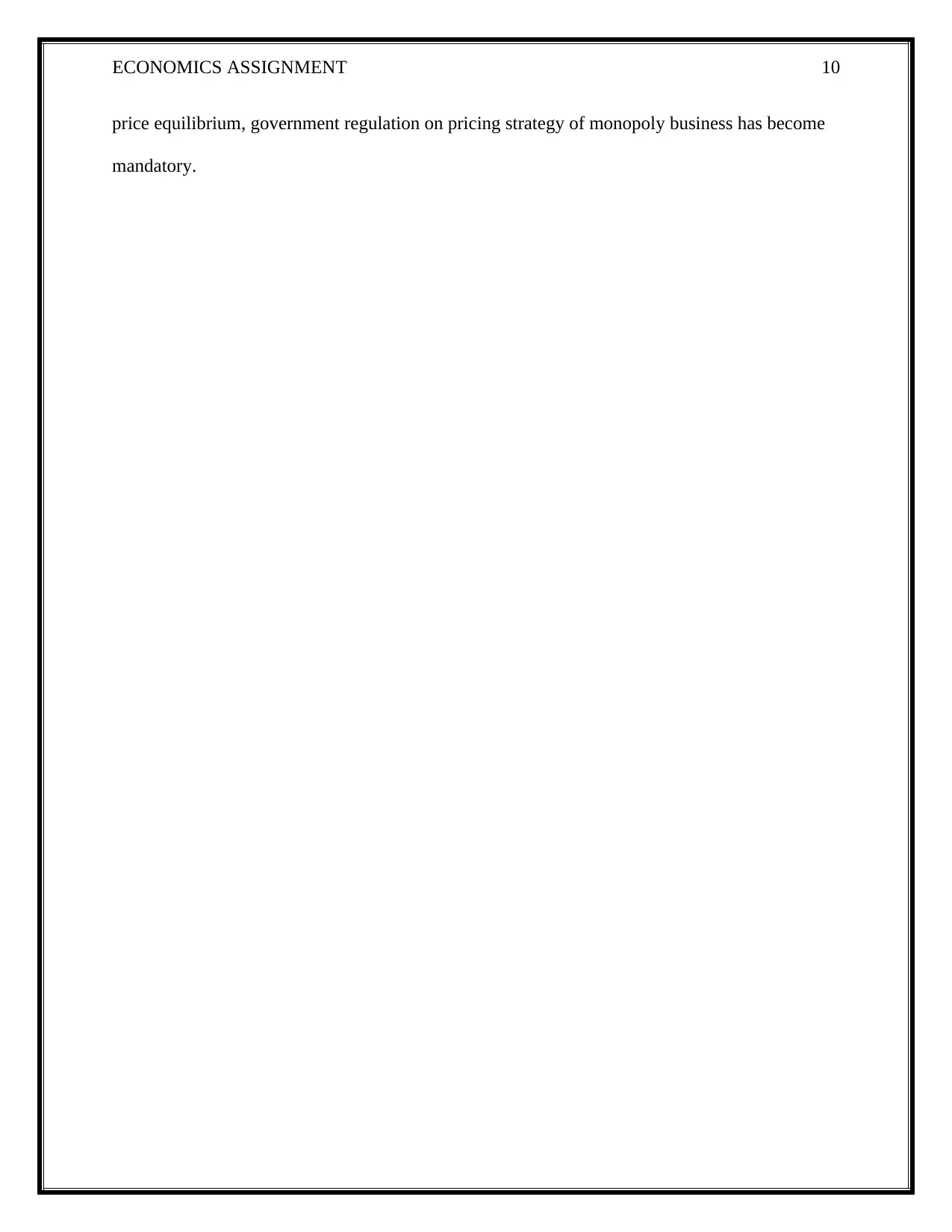
ECONOMICS ASSIGNMENT 10
price equilibrium, government regulation on pricing strategy of monopoly business has become
mandatory.
price equilibrium, government regulation on pricing strategy of monopoly business has become
mandatory.
Paraphrase This Document
Need a fresh take? Get an instant paraphrase of this document with our AI Paraphraser
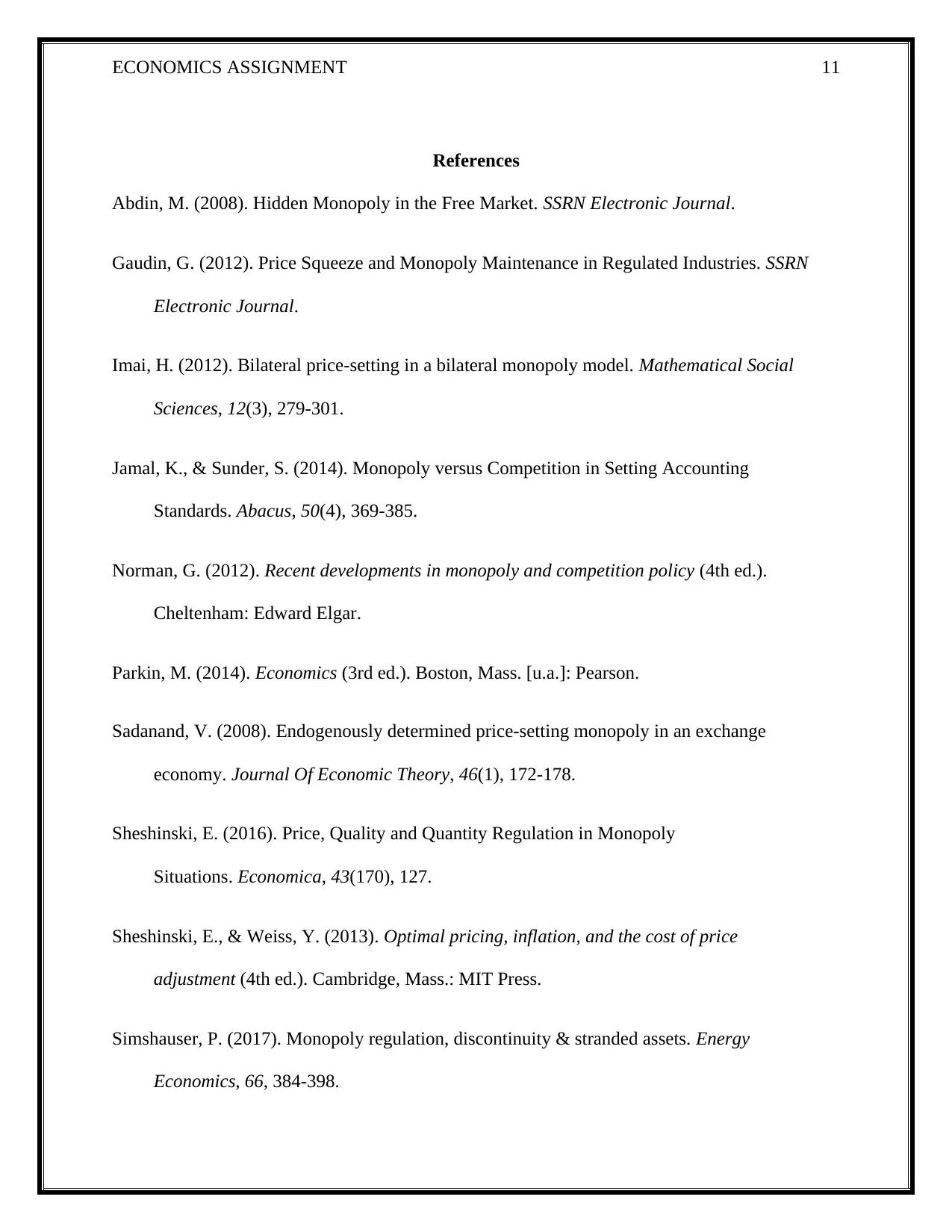
ECONOMICS ASSIGNMENT 11
References
Abdin, M. (2008). Hidden Monopoly in the Free Market. SSRN Electronic Journal.
Gaudin, G. (2012). Price Squeeze and Monopoly Maintenance in Regulated Industries. SSRN
Electronic Journal.
Imai, H. (2012). Bilateral price-setting in a bilateral monopoly model. Mathematical Social
Sciences, 12(3), 279-301.
Jamal, K., & Sunder, S. (2014). Monopoly versus Competition in Setting Accounting
Standards. Abacus, 50(4), 369-385.
Norman, G. (2012). Recent developments in monopoly and competition policy (4th ed.).
Cheltenham: Edward Elgar.
Parkin, M. (2014). Economics (3rd ed.). Boston, Mass. [u.a.]: Pearson.
Sadanand, V. (2008). Endogenously determined price-setting monopoly in an exchange
economy. Journal Of Economic Theory, 46(1), 172-178.
Sheshinski, E. (2016). Price, Quality and Quantity Regulation in Monopoly
Situations. Economica, 43(170), 127.
Sheshinski, E., & Weiss, Y. (2013). Optimal pricing, inflation, and the cost of price
adjustment (4th ed.). Cambridge, Mass.: MIT Press.
Simshauser, P. (2017). Monopoly regulation, discontinuity & stranded assets. Energy
Economics, 66, 384-398.
References
Abdin, M. (2008). Hidden Monopoly in the Free Market. SSRN Electronic Journal.
Gaudin, G. (2012). Price Squeeze and Monopoly Maintenance in Regulated Industries. SSRN
Electronic Journal.
Imai, H. (2012). Bilateral price-setting in a bilateral monopoly model. Mathematical Social
Sciences, 12(3), 279-301.
Jamal, K., & Sunder, S. (2014). Monopoly versus Competition in Setting Accounting
Standards. Abacus, 50(4), 369-385.
Norman, G. (2012). Recent developments in monopoly and competition policy (4th ed.).
Cheltenham: Edward Elgar.
Parkin, M. (2014). Economics (3rd ed.). Boston, Mass. [u.a.]: Pearson.
Sadanand, V. (2008). Endogenously determined price-setting monopoly in an exchange
economy. Journal Of Economic Theory, 46(1), 172-178.
Sheshinski, E. (2016). Price, Quality and Quantity Regulation in Monopoly
Situations. Economica, 43(170), 127.
Sheshinski, E., & Weiss, Y. (2013). Optimal pricing, inflation, and the cost of price
adjustment (4th ed.). Cambridge, Mass.: MIT Press.
Simshauser, P. (2017). Monopoly regulation, discontinuity & stranded assets. Energy
Economics, 66, 384-398.
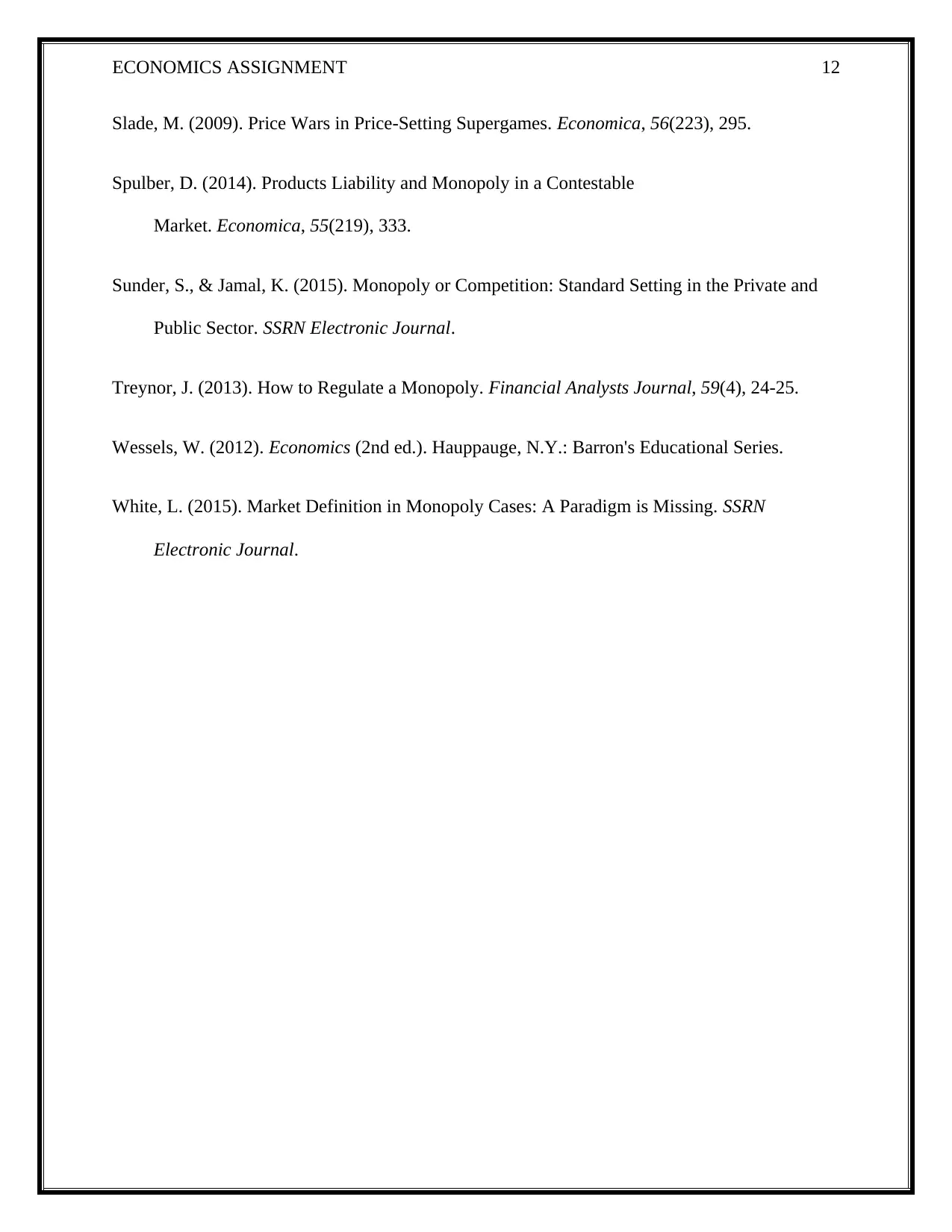
ECONOMICS ASSIGNMENT 12
Slade, M. (2009). Price Wars in Price-Setting Supergames. Economica, 56(223), 295.
Spulber, D. (2014). Products Liability and Monopoly in a Contestable
Market. Economica, 55(219), 333.
Sunder, S., & Jamal, K. (2015). Monopoly or Competition: Standard Setting in the Private and
Public Sector. SSRN Electronic Journal.
Treynor, J. (2013). How to Regulate a Monopoly. Financial Analysts Journal, 59(4), 24-25.
Wessels, W. (2012). Economics (2nd ed.). Hauppauge, N.Y.: Barron's Educational Series.
White, L. (2015). Market Definition in Monopoly Cases: A Paradigm is Missing. SSRN
Electronic Journal.
Slade, M. (2009). Price Wars in Price-Setting Supergames. Economica, 56(223), 295.
Spulber, D. (2014). Products Liability and Monopoly in a Contestable
Market. Economica, 55(219), 333.
Sunder, S., & Jamal, K. (2015). Monopoly or Competition: Standard Setting in the Private and
Public Sector. SSRN Electronic Journal.
Treynor, J. (2013). How to Regulate a Monopoly. Financial Analysts Journal, 59(4), 24-25.
Wessels, W. (2012). Economics (2nd ed.). Hauppauge, N.Y.: Barron's Educational Series.
White, L. (2015). Market Definition in Monopoly Cases: A Paradigm is Missing. SSRN
Electronic Journal.
⊘ This is a preview!⊘
Do you want full access?
Subscribe today to unlock all pages.

Trusted by 1+ million students worldwide
1 out of 12
Related Documents
Your All-in-One AI-Powered Toolkit for Academic Success.
+13062052269
info@desklib.com
Available 24*7 on WhatsApp / Email
![[object Object]](/_next/static/media/star-bottom.7253800d.svg)
Unlock your academic potential
Copyright © 2020–2025 A2Z Services. All Rights Reserved. Developed and managed by ZUCOL.





